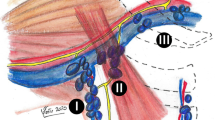Abstract.
Usually when using imaging procedures, such as axillary mammography or ultrasonography, a cutoff level of 5 mm for lymph node size is postulated to be not only the limit of lymph node visibility but also a sign of metastatic involvement. The aim of this study was to evaluate whether this assumption, used as a basic hypothesis in many reports, is true. A series of 72 axillary specimens from 71 breast carcinoma patients operated at the university hospital of Vienna were analyzed. A comparison of histologically noninvolved axillary specimens with those showing metastatic involvement revealed that the two groups did not differ significantly according to the number or size of lymph nodes per axilla. For lymph nodes <5 mm the probability of being metastatically involved was still 10%. Enlarged lymph nodes (5–20 mm) had a slightly higher risk of being malignant (20%). In contrast, the probability of metastatic involvement for lymph nodes >20 mm was only 40%. We suggest that many reports dealing with the prediction of malignancy in axillary lymph nodes may have used misleading basic assumptions, so the results of these studies must be viewed critically.
Similar content being viewed by others
Author information
Authors and Affiliations
Rights and permissions
About this article
Cite this article
Obwegeser, R., Lorenz, K., Hohlagschwandtner, M. et al. Axillary Lymph Nodes in Breast Cancer: Is Size Related to Metastatic Involvement?. World J. Surg. 24, 546–550 (2000). https://doi.org/10.1007/s002689910088
Published:
Issue Date:
DOI: https://doi.org/10.1007/s002689910088




